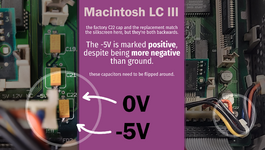paul.gaastra
Member
Uniserver said
It's no use me taking a photograph of the board I recapped correctly because I put the tantalums on upside down and soldered fuse wire to the pads. So you can't see the capacitor markings. I do that because I am afraid of shorting the pads to the ground plane. Generally the terminals of SMT tantalums are wider than the pad of the original electolytics. It makes for a lot of work and really makes a mess.Can some one please take a nice picture so people can visually see how it should be and post it in this LC-III Caps! thread?

